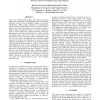Free Online Productivity Tools
i2Speak
i2Symbol
i2OCR
iTex2Img
iWeb2Print
iWeb2Shot
i2Type
iPdf2Split
iPdf2Merge
i2Bopomofo
i2Arabic
i2Style
i2Image
i2PDF
iLatex2Rtf
Sci2ools
ICAD
2004
2004
Selective and Divided Attention: Extracting Information from Simultaneous Sound Sources
The way in which sounds interact and interfere with each other (both acoustically and perceptually) has an important influence on how well an auditory display can convey information. While spatial separation of simultaneous sound sources has been shown to be very effective when a listener must report the content of one source and ignore another source (a condition known as selective attention), little is known about how spatial separation influences performance in divided-attention tasks, i.e., tasks in which the listener must report the content of more than one simultaneous source. This paper reports preliminary results from a pilot study investigating how perceived spatial separation of sources and consistency in source locations influences performance on selective- and divided-attention tasks. Results demonstrate that 1) in both selective- and divided-attention tasks, overall performance is generally better when sources are perceived at different locations than when they are percei...
| Added | 31 Oct 2010 |
| Updated | 31 Oct 2010 |
| Type | Conference |
| Year | 2004 |
| Where | ICAD |
| Authors | Barbara G. Shinn-Cunningham, Antje Ihlefeld |
Comments (0)

